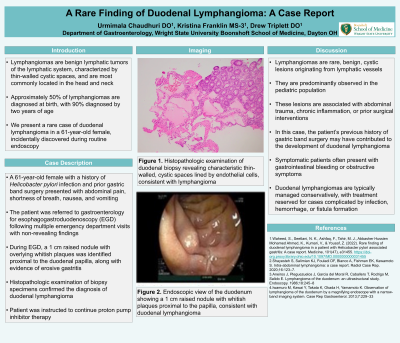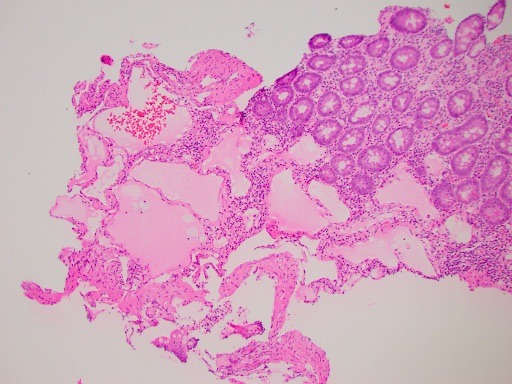Monday Poster Session
Category: Small Intestine
P3216 - A Rare Finding of Duodenal Lymphangioma: A Case Report
Monday, October 28, 2024
10:30 AM - 4:00 PM ET
Location: Exhibit Hall E

Has Audio

Urmimala Chaudhuri, DO
Wright State University
Centerville, OH
Presenting Author(s)
Urmimala Chaudhuri, DO1, Krisitina Franklin, BS2, Drew Triplett, DO3
1Wright State University, Centerville, OH; 2Ohio University School of Osteopathic Medicine, Dayton, OH; 3Wright State University, Dayton, OH
Introduction: Lymphangiomas are benign lymphatic tumors that are composed of thin-walled cysts and normally found in the head and neck. About 50% are diagnosed at birth and 90% by 2 years. Therefore, it is an extremely rare diagnosis in adults. We present a rare case of a duodenal lymphangioma in a 61-year-old female, which was incidentally found during an EGD.
Case Description/Methods: A 61-year-old female with a prior history of H. pylori and gastric band surgery (converted to sleeve gastrectomy) presented with abdominal pain, shortness of breath, nausea, and vomiting. Patient was referred to gastroenterology for esophagogastroduodenoscopy (EGD) after multiple ER visits did not reveal remarkable findings. During the EGD, she was noted to have erosive gastritis and notably, a 1-cm raised nodule with whitish plaques proximal to the duodenal papilla. Biopsy results from the duodenal portion confirmed the presence of a lymphangioma ruling out celiac sprue, H. pylori, and other infectious microorganisms. For management, we counseled the patient to continue proton pump inhibitor (PPI) therapy.
Discussion: Lymphangiomas are unusual cystic lesions originating from lymphatic vessels, with a higher incidence observed in the pediatric population. The etiology of lymphangiomas may be associated with factors such as abdominal trauma, inflammation, or previous surgeries. In this case, the patient's history of lap band surgery, later converted to gastric sleeve, is considered a potential contributing factor to the development of the duodenal lymphangioma. Clinical manifestations of duodenal lymphangiomas vary widely, ranging from asymptomatic incidental findings to severe gastrointestinal bleeding and obstructive symptoms. Duodenal lymphangiomas are generally benign and typically do not necessitate treatment unless complicated by infection, hemorrhage, or fistula formation.
The etiology of duodenal lymphangiomas remains incompletely understood, with limited definitive risk factors identified in the medical literature. Clinical presentations are highly diverse, ranging from asymptomatic incidental discoveries to severe gastrointestinal symptoms. Given the intricate clinical nature of duodenal lymphangiomas, a multidisciplinary approach is essential to ensure accurate diagnosis and optimal management.

Disclosures:
Urmimala Chaudhuri, DO1, Krisitina Franklin, BS2, Drew Triplett, DO3. P3216 - A Rare Finding of Duodenal Lymphangioma: A Case Report, ACG 2024 Annual Scientific Meeting Abstracts. Philadelphia, PA: American College of Gastroenterology.
1Wright State University, Centerville, OH; 2Ohio University School of Osteopathic Medicine, Dayton, OH; 3Wright State University, Dayton, OH
Introduction: Lymphangiomas are benign lymphatic tumors that are composed of thin-walled cysts and normally found in the head and neck. About 50% are diagnosed at birth and 90% by 2 years. Therefore, it is an extremely rare diagnosis in adults. We present a rare case of a duodenal lymphangioma in a 61-year-old female, which was incidentally found during an EGD.
Case Description/Methods: A 61-year-old female with a prior history of H. pylori and gastric band surgery (converted to sleeve gastrectomy) presented with abdominal pain, shortness of breath, nausea, and vomiting. Patient was referred to gastroenterology for esophagogastroduodenoscopy (EGD) after multiple ER visits did not reveal remarkable findings. During the EGD, she was noted to have erosive gastritis and notably, a 1-cm raised nodule with whitish plaques proximal to the duodenal papilla. Biopsy results from the duodenal portion confirmed the presence of a lymphangioma ruling out celiac sprue, H. pylori, and other infectious microorganisms. For management, we counseled the patient to continue proton pump inhibitor (PPI) therapy.
Discussion: Lymphangiomas are unusual cystic lesions originating from lymphatic vessels, with a higher incidence observed in the pediatric population. The etiology of lymphangiomas may be associated with factors such as abdominal trauma, inflammation, or previous surgeries. In this case, the patient's history of lap band surgery, later converted to gastric sleeve, is considered a potential contributing factor to the development of the duodenal lymphangioma. Clinical manifestations of duodenal lymphangiomas vary widely, ranging from asymptomatic incidental findings to severe gastrointestinal bleeding and obstructive symptoms. Duodenal lymphangiomas are generally benign and typically do not necessitate treatment unless complicated by infection, hemorrhage, or fistula formation.
The etiology of duodenal lymphangiomas remains incompletely understood, with limited definitive risk factors identified in the medical literature. Clinical presentations are highly diverse, ranging from asymptomatic incidental discoveries to severe gastrointestinal symptoms. Given the intricate clinical nature of duodenal lymphangiomas, a multidisciplinary approach is essential to ensure accurate diagnosis and optimal management.

Figure: Lymphangioma Revealing Cavernous and Cystic Lymphatic Channels Enlarging and Disrupting the Duodenal Mucosa
Disclosures:
Urmimala Chaudhuri indicated no relevant financial relationships.
Krisitina Franklin indicated no relevant financial relationships.
Drew Triplett indicated no relevant financial relationships.
Urmimala Chaudhuri, DO1, Krisitina Franklin, BS2, Drew Triplett, DO3. P3216 - A Rare Finding of Duodenal Lymphangioma: A Case Report, ACG 2024 Annual Scientific Meeting Abstracts. Philadelphia, PA: American College of Gastroenterology.
